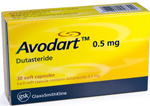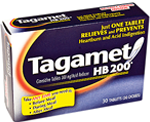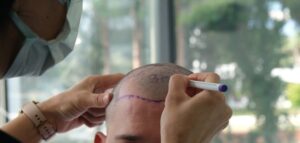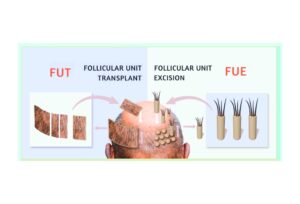Although minoxidil and finasteride are the two hair loss treatments that have been FDA-approved, they’re not the only treatments available. Below are two treatments that many men have found to help in their battle against hair loss.
HOW TO CARE FOR OUR HAIR & HAIR FOLLICLES.
Hair Loss Medication
The following six medications are most commonly prescribed for hair loss. Click on a medication name to skip to it on this page.
Dutasteride (Avodart)
How does DUT work?
 Dutasteride, similarly to Finasteride (Propecia) acts as an inhibitor of the enzyme responsible for the conversion of testosterone to DHT (dihydrotestosterone). DHT is the hormone responsible for male pattern baldness. Unlike finasteride, which only inhibits the Type I form of the enzyme, dutasteride inhibits both the Type I and Type II forms of the 5 alpha-reductase enzyme. This characteristic makes the drug broader-spectrum and therefore, more potent. The higher potency means often more effective results but also increases the chance that the patient will experience side effects.
Dutasteride, similarly to Finasteride (Propecia) acts as an inhibitor of the enzyme responsible for the conversion of testosterone to DHT (dihydrotestosterone). DHT is the hormone responsible for male pattern baldness. Unlike finasteride, which only inhibits the Type I form of the enzyme, dutasteride inhibits both the Type I and Type II forms of the 5 alpha-reductase enzyme. This characteristic makes the drug broader-spectrum and therefore, more potent. The higher potency means often more effective results but also increases the chance that the patient will experience side effects.
What are DUT side effects?
Possible side effects of dutasteride include impotence, decreased libido, breast disorders (gynecomastia), and ejaculation disorders.
The display of most drug-related sexual adverse reactions has been shown to decrease with the duration of treatment. The half-life of the drug is 5 weeks and therefore, once dosage has been discontinued, the patient can be sure that any adverse reactions will cease within 5 weeks.
Does DUT work better than Propecia?
Dutasteride when administered 0.5mg/day has been shown to decrease serum DHT levels by 91% and scalp DHT levels by 54%. Whereas Finasteride administered 5mg/day decreases serum DHT levels by 71% and scalp DHT levels by 38%. Based on these results, dutasteride shows to be significantly more effective than finasteride.
A study by Olsen et al. published in the Journal of the American Academy of Dermatology in 2006 has shown the benefits of dutasteride over finasteride in a scientifically rigorous, placebo-controlled study.
Detailed study by EA Olsen comparing Avodart to Propecia
See full prescribing information on Dutasteride (Avodart).
Minoxidil (Rogaine)
How does Minoxidil work?
 Minoxidil is a vasodilator medication that was first used to treat high blood pressure. The exact mechanism by which minoxidil functions to stimulate hair growth is unknown. It has been proven, however, that the drug increases diameter and length plus the duration of the growth cycle of a single hair follicle. Rogaine is the brand name for minoxidil and was the first FDA-approved medication for the treatment of hair loss. Rogaine is a topical solution that is applied directly to the scalp. It can be purchased without a prescription, and in generic formulations in concentrations of 5% (for men) and 2% (for women).
Minoxidil is a vasodilator medication that was first used to treat high blood pressure. The exact mechanism by which minoxidil functions to stimulate hair growth is unknown. It has been proven, however, that the drug increases diameter and length plus the duration of the growth cycle of a single hair follicle. Rogaine is the brand name for minoxidil and was the first FDA-approved medication for the treatment of hair loss. Rogaine is a topical solution that is applied directly to the scalp. It can be purchased without a prescription, and in generic formulations in concentrations of 5% (for men) and 2% (for women).
Does Minoxidil only work on the crown area? Where on the scalp does it work best?
The original studies for the drug’s effect on hair growth were performed on the crown, so most people think about the drug as being most effective in this area. It has however been shown that minoxidil, although usually showing the best results on the crown, also works to promote hair growth on other areas of the scalp. In order for the drug to be effective, there needs to be some hair present. It does not work when the area is totally bald.
Should I use Minoxidil along with Propecia or Avodart?
The simultaneous use of minoxidil and Propecia, which directly inhibits the formation of DHT, may have some synergistic benefit in the treatment of hair loss, although the latter medication is significantly more effective.
What are the side effects of Minoxidil?
The most common side effect associated with minoxidil is an itchy scalp. This is due largely to the alcohol that is present in topical preparations of the drug. Side-effects of oral minoxidil may include swelling of the face and extremities, rapid and irregular heartbeat, lightheadedness, cardiac lesions, and focal necrosis of the papillary muscle and subendocardial areas of the left ventricle. There have been cases of allergic reactions to minoxidil or the non-active ingredient propylene glycol, which is found in some forms of topical Rogaine.
Do I need to use Minoxidil twice a day? Should I use the 2%, 5% 6% or even 12%?
Pfizer, the company that makes Rogaine, states that the drug will be less effective if used only once a day. However, practical usage of the drug has shown that once-a-day topical application of minoxidil 2% and 6% and 12%, is just as effective as a twice-a-day application. This is because when topically applied, the drug has a half-life of 22 hours on the skin. So applying it twice within the 22 hours does not improve the results. To improve the results, a higher dosage is normally recommended as opposed to the twice-a-day application.
Can women use Minoxidil?
Women are generally more sensitive to minoxidil especially to the vasodilating effects of the drug often showing a decrease in blood pressure (hypotension). Therefore only the 2% concentration is recommended.
Also worth mentioning is the local reaction of facial hair growth that some women see from topical application of minoxidil. Any hair that appears due to the medication will shed when the treatment is discontinued. However, it should be noted that there is a significantly greater incidence of these side effects when the 5% solution is used.
See full prescribing information on Minoxidil (Rogaine).
Finasteride (Propecia)
How does Finasteride work?
 Finasteride is a drug that works by blocking an enzyme that converts testosterone to dihydrotestosterone (DHT) in the hair follicle. DHT is the male hormone responsible for male pattern baldness. Propecia, the brand name for finasteride, is the only FDA-approved oral medication for hair loss.
Finasteride is a drug that works by blocking an enzyme that converts testosterone to dihydrotestosterone (DHT) in the hair follicle. DHT is the male hormone responsible for male pattern baldness. Propecia, the brand name for finasteride, is the only FDA-approved oral medication for hair loss.
Finasteride causes the levels of DHT to drop in both the scalp and blood. When administered, Finasteride 1-mg/day patients generally see a decrease in DHT levels by 70%.
A 5-year study showed that 90% of men administered Propecia (finasteride 1mg) will maintain existing hair or experience regrowth. 48% of these men experienced regrowth of hair, while 42% experienced no additional hair loss.
Propecia is effective only for as long as it is taken; the hair gained or maintained is lost within 6–12 months of ceasing therapy. In clinical studies, Propecia, like minoxidil, was shown to work on both the crown area and the hairline, but is most successful in the crown area.
What are the side effects of Finasteride?
The recognized side-effects associated with finasteride are erectile dysfunction in 1% of users and even less often gynecomastia (breast gland enlargement). Finasteride has a half-life of 6-8 hours, meaning 6-8 hours after dosage it will have entirely left the patient’s system. Studies confirm that any side-effects related to the drug cease after the dosage is discontinued.
Can women take Propecia?
It should be noted firstly that hair loss in women is related more to the action of the enzyme aromatase (which is unaffected by finasteride) rather than DHT.
Finasteride generally is not indicated for use by women. Finasteride is in the FDA pregnancy category X. This means that it is known to cause birth defects in an unborn baby.
However, exposure of pregnant women to semen from men treated with Propecia poses no risk to the fetus.
See full prescribing information on Finasteride (Propecia).
A detailed study by EA Olsen comparing Avodart to Propecia
Bimatoprost (Latisse)
What is Latisse?
 Latisse is a topical medication approved by the FDA to make eyelashes longer, thicker and darker. It is should be applied once a day and has shown to have a 75% success rate among users. The effects of Latisse on eyelash growth take approximately 16 weeks to show.
Latisse is a topical medication approved by the FDA to make eyelashes longer, thicker and darker. It is should be applied once a day and has shown to have a 75% success rate among users. The effects of Latisse on eyelash growth take approximately 16 weeks to show.
How do I use Latisse?
Latisse is a topical solution applied once a day to the top eyelashes. By blinking, the solution will transfer on its own to the bottom lashes.
How does Latisse work?
Latisse is composed of a compound called Bimatoprost. Bimatoprost comes from fatty acids and naturally binds to prostaglandin (PG) receptors. These PG receptors are present in the hair follicle, and the presence of Bimaprost has shown to increase the per cent of hairs in the growth phase of the hair cycle. The long-term safety of Latisse/ Bimatoprost as a hair growth stimulant has been based on clinical trials over 13 years.
Can I grow hair elsewhere with Latisse?
Latisse has been approved for use on eyelashes. Potential benefits of the drug on other areas such as eyebrows and scalp hair are currently being tested.
See full prescribing information on Bimatoprost (Latisse).
Aldactone / Spironolactone
 Spironolactone, or the more popular brand name, Aldactone, is in a class of drugs called potassium-sparing diuretics (water pill). It is used to reduce the amount of fluid in your body, without causing the loss of potassium. It is also used to treat hypertension (high blood pressure) and oedema (swelling) and used to treat potassium deficiency and hyperaldosteronism (a hormonal disorder).
Spironolactone, or the more popular brand name, Aldactone, is in a class of drugs called potassium-sparing diuretics (water pill). It is used to reduce the amount of fluid in your body, without causing the loss of potassium. It is also used to treat hypertension (high blood pressure) and oedema (swelling) and used to treat potassium deficiency and hyperaldosteronism (a hormonal disorder).
Spironolactone is an antiandrogen that works in two ways. Primarily, it slows down the production of androgens in the adrenal glands and ovaries. Secondly, it blocks the action of androgens, in part, by preventing dihydrotestosterone from binding to its androgenetic receptor.
See full prescribing information on Aldactone (Spironolactone).
Tagamet / Cimetidine
 Cimetidine, sold under the brand name, Tagamet, belongs to a class of histamine-blockers used mainly to treat gastrointestinal ulcers. The histamine blocking action prevents the stomach from producing excess acid, allowing the body to heal the ulcer. Cimetidine also has a fairly powerful anti-androgenic effect and has shown to block dihydrotestosterone from binding to the follicle receptor sites.
Cimetidine, sold under the brand name, Tagamet, belongs to a class of histamine-blockers used mainly to treat gastrointestinal ulcers. The histamine blocking action prevents the stomach from producing excess acid, allowing the body to heal the ulcer. Cimetidine also has a fairly powerful anti-androgenic effect and has shown to block dihydrotestosterone from binding to the follicle receptor sites.
Cimetidine has been used to treat hirsutism in women (excess facial hair growth) and has been studied in women with androgenic alopecia, showing promising results. Because of the high doses needed to achieve its hair-raising results, men should not take cimetidine to treat their hair loss, due to possible feminizing effects including adverse sexual side effects.

















